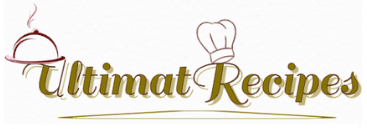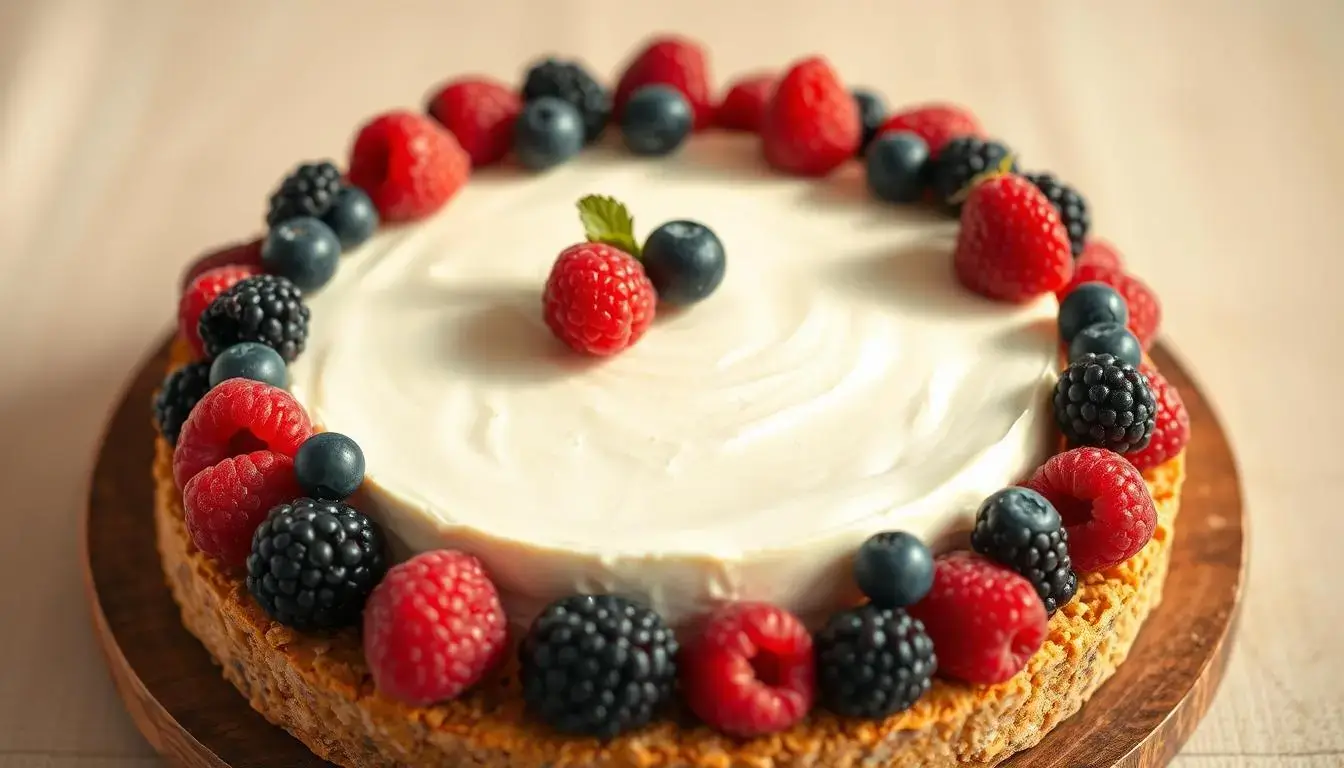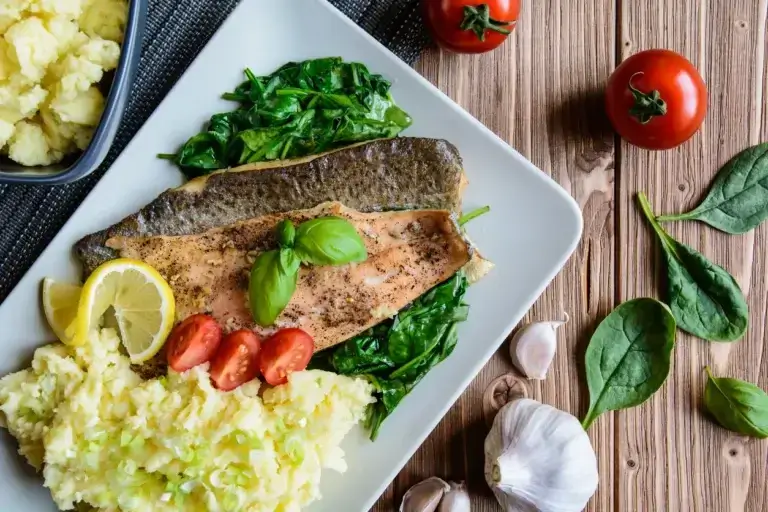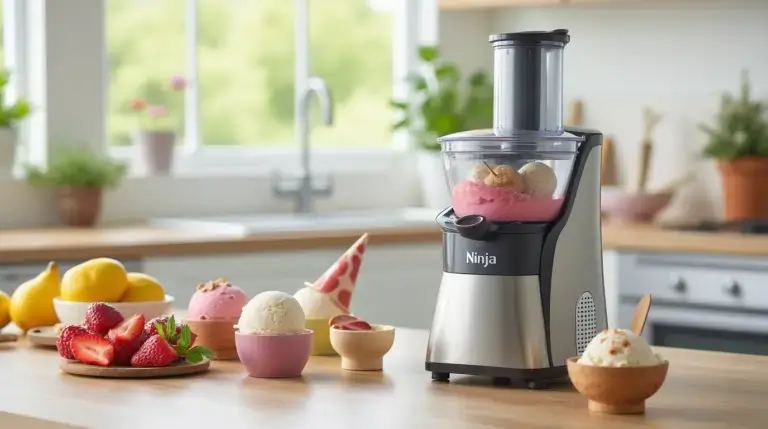Cottage Cheese Cheesecake From Scratch
Table of Contents
Do you remember the first time you had a perfectly baked cheesecake?
That moment when the fork goes into a creamy layer, showing a tangy-sweet center that melts in your mouth? That’s the magic of cottage cheese cheesecake—a dessert that’s both rich and easy to make.
Making it from scratch is more than just following a recipe. It’s about creating a flavor that’s all your own. Imagine sharing a slice with friends, knowing each creamy bite came from simple ingredients like real cottage cheese and a bit of vanilla. This isn’t just baking—it’s celebrating texture, tradition, and the joy of cooking at home.
cottage cheese cheesecake
This guide will show you how to turn fresh cottage cheese into a dessert that’s both lighter and richer than traditional cream cheese cheesecakes. You’ll see why this recipe is a game-changer: it’s budget-friendly, full of protein, and fits every taste. By the end, you’ll know how to balance tangy curds with a golden crust, making every slice a success.
Key Takeaways
- Learn to craft a silky texture using real cottage cheese instead of store-bought mixes.
- Discover how this recipe saves time and money compared to traditional cheesecake methods.
- Unlock the nutritional benefits of cottage cheese, like higher protein and lower sugar.
- Get tips to avoid common baking mistakes and achieve a flawlessly smooth finish.
- Explore how this classic dessert bridges homemade creativity and modern dietary preferences.
Why Cottage Cheese Makes the Perfect Cheesecake Base
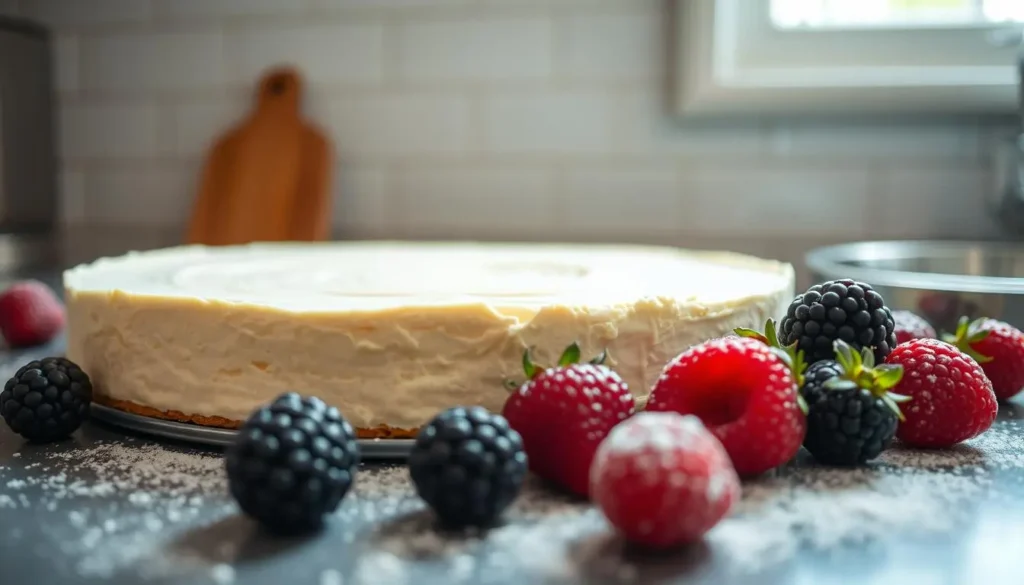
cottage cheese cake base benefits
Cottage cheese cake is a hit for bakers looking to try something new. It has many benefits:
Nutritional Benefits of Using Cottage Cheese
Cottage cheese is a great choice for those who want more protein. It has half the fat and twice the protein of cream cheese. This makes your cake rich in taste but lower in calories.
Texture Advantages Over Traditional Cream Cheese
- Moisture-rich curds make the cake fluffy and tender
- Natural acidity helps prevent baking cracks
- It’s less tangy, so the flavor is balanced
Cost-Effectiveness of Cottage Cheese Desserts
Cottage cheese is very affordable, costing about 30% less than cream cheese. This means you can make big cottage cheese cake servings without spending too much. It’s great for family events or when you’re on a budget.
Chefs all over the U.S. are finding new uses for cottage cheese. It’s perfect for those who care about nutrition, texture, or saving money. Cottage cheese is more than just a substitute; it’s a key ingredient for modern desserts.
Essential Ingredients for Your Cottage Cheese Cake
Making the perfect cottage cheese yogurt cheesecake begins with the right ingredients. Each part is crucial for texture, taste, and how it holds together. Let’s look at what you’ll need:
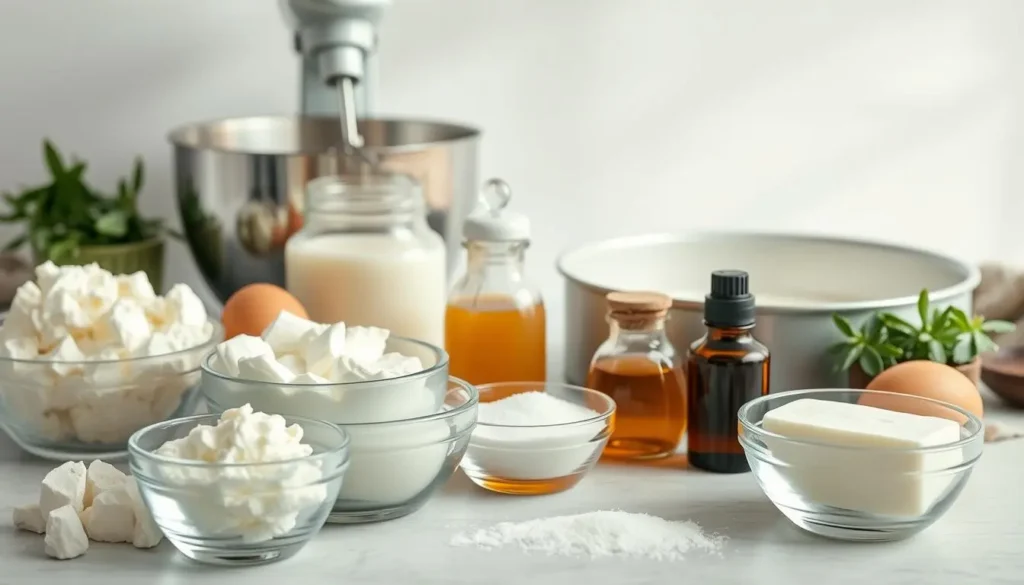
cottage cheese yogurt cheesecake ingredients
- Cottage cheese: Pick full-fat for creaminess or low-fat for a lighter taste. Small-curd types mix better in the cottage cheese yogurt cheesecake base.
- Greek yogurt: It adds tang and moisture, balancing the cheesecake’s richness. Choose plain, unflavored Greek yogurt.
- Sugar: Granulated sugar sweetens it, but honey or maple syrup offer natural sweetness.
- Eggs: They give structure—use room temperature eggs for better mixing.
- Vanilla or citrus zest: They enhance flavor without overwhelming the cheese’s taste.
“For a vegan alternative, replace eggs with aquafaba and opt for coconut yogurt.” – Dairy Alternatives Specialist
Optional ingredients like almond essence or cinnamon add depth. A graham cracker crust brings it all together. Always check labels: choose unsalted butter for crusts to control salt. With these basics, you’re set to start the recipe!
The History and Evolution of Cottage Cheese Cheesecake
From ancient farmsteads to modern kitchens, cottage cheese cheesecake has traveled far. Its story begins in Europe, where farmers made savory curd cakes to keep dairy fresh. These early cakes were simple, made with fresh cheese, honey, or herbs.
European Origins of Curd Cheesecakes
- Poland’s osiński ser cakes date back centuries, often baked in clay molds.
- Russian syrniki were fried cheese patties, later adapted into baked desserts.
- German Käsekuchen used quark cheese, becoming a staple in regional festivals.
American Adaptations and Modern Variations
Immigrants brought these recipes to the U.S., where cottage cheese became the main ingredient. During the Great Depression, it was a cheap alternative to cream cheese. Now, chefs add raspberries, caramel, or even espresso to the mix.
Cultural Significance in Different Cuisines
| Culture | Traditional Recipe | Modern Twist |
|---|---|---|
| Polish | Honey-sweetened with poppy seeds | Matcha green tea variations |
| Ukrainian | Syrniki with sour cream topping | Cinnamon sugar-dusted mini cakes |
| American | Depression-era walnut-studded | Gluten-free coconut flour bases |
Every bite of your homemade cottage cheese cheesecake connects you to a rich legacy. See how traditions meet innovation in every recipe you bake.
Equipment You’ll Need for Perfect Results
Mastering the easy cheesecake recipe starts with the right tools. Let’s break down what’s essential and what’s optional to avoid kitchen mishaps.
- Springform Pan: A 9-inch stainless steel or glass pan prevents leaks better than cheaper metals. Check for tight latches—loose ones cause spills.
- Food Processor: Purees cottage cheese into a smooth base. A blender works in a pinch.
- Oven Thermometer: Ensures your oven’s temperature is accurate—critical for even baking.
- Water Bath Setup: A roasting pan holds hot water around your cheesecake to prevent cracking.
| Pan Material | Pros | Cons |
|---|---|---|
| Stainless Steel | Even heating, durable | Risk of warping |
| Glass | No metal taste, oven-safe | Heavier to handle |
| Aluminum | Cost-effective | Prone to rust if low quality |
If you lack a food processor, finely crushed graham crackers and a whisk work for the crust. For the water bath, place your pan in a larger dish filled halfway with hot water. Pro tip: Wrap the pan’s bottom in foil before submerging to block leaks. With these tools, your easy cheesecake recipe will rise flawlessly every time.
Step-by-Step Cottage Cheese Cheesecake Recipe
Learning to make an easy cheesecake recipe is easy. Follow these steps to make a smooth cottage cheese cake every time:
Preparing Your Cottage Cheese Base
Start by blending 2 cups of drained cottage cheese with ½ cup of Greek yogurt in a food processor. Make sure it’s smooth. Then, strain the mixture through cheesecloth for 10 minutes to get rid of extra liquid. This keeps your cottage cheese cake thick and creamy.
Creating the Perfect Crust
| Option | Ingredients |
|---|---|
| Graham Cracker Crust | 1½ cups crushed graham crackers + 6 tbsp melted butter + ¼ cup sugar |
| Gluten-Free Option | Almond flour + coconut oil + sweetener of choice |
Press the crust mixture into a 9-inch pan with a springform base. Bake at 350°F for 10 minutes until it’s golden.
Mixing and Baking Techniques
- Beat 1 cup of softened cream cheese with 1 cup of sugar until it’s light and fluffy.
- Then, gently mix in the cottage cheese mixture and 3 well-beaten eggs (room temperature).
- Pour the mix into the prebaked crust. Bake at 325°F for 50 minutes, then lower the oven to 275°F for the last 20 minutes.
Cooling and Setting Methods
- Allow the cheesecake to cool in the oven with the door slightly open for 1 hour.
- Then, move it to the countertop for 4 hours before refrigerating it uncovered overnight.
- This slow cooling helps prevent cracks and ensures it sets right.
Troubleshooting Common Cheesecake Problems
Cracks, sogginess, or a lumpy texture can ruin even the best cheesecake with Greek yogurt. Here’s how to fix these issues before they spoil your dessert:
- Cracks: Overbaking or rapid cooling causes splits. Add ¼ cup Greek yogurt to your batter—it adds moisture that keeps the filling flexible.
- Sunken center: Overmixing deflates air bubbles. Mix ingredients until just combined and let your cheesecake with Greek yogurt cool slowly in a turned-off oven.
- Grainy texture: Lumpy cottage cheese ruins smoothness. Blend your ingredients in a food processor until silky before baking.
- Soggy crust: Bake your crust 10 minutes before adding filling. Use a 1:2 ratio of crumbs to melted butter for stability.
Always chill cheesecakes overnight. A cracked surface? Try a caramel drizzle or fresh berries to mask imperfections. For a perfectly set dessert, use full-fat Greek yogurt—it stabilizes the filling better than low-fat options. Remember: patience and precise measurements are key. With these fixes, even a flawed batch becomes a winner.
Delicious Variations of Cottage Cheese Yogurt Cheesecake
Once you’ve mastered the basic cottage cheese yogurt cheesecake, it’s time to get creative. These variations let you adapt the recipe to any flavor or occasion. They keep the recipe’s signature creaminess intact. Start experimenting today!
Fruit-Topped Versions
Add bursts of freshness with seasonal fruits. Try:
- Strawberry rhubarb compote for spring
- Mango-chili glaze for tropical flair
- Fig and balsamic reduction in autumn
Pro tip: Top with berries just before serving to preserve their vibrant colors.
Chocolate and Flavor Infusions
Infuse your cream cheese yogurt cheesecake with:
- Cocoa powder for a mocha twist
- Orange zest and Grand Marnier for a zesty kick
- Cardamom or cinnamon for aromatic depth
Adjust baking time by 5-10 minutes when adding dense ingredients like chocolate chips.
No-Bake Cottage Cheese Cheesecake Options
Beat the heat with no-bake versions:
| Option | Key Ingredient | Texture |
|---|---|---|
| Classic | Marshmallow fluff | Light & airy |
| Summer special | Cream of coconut | Lush tropical |
| Gluten-free | Coconut milk gelatin | Firm set |
Use 2:1 ratio of cottage cheese to yogurt for stability in no-bake styles.
Mix both cottage cheese yogurt cheesecake and cream cheese yogurt cheesecake elements for hybrid recipes. Swap 1/3 of the cottage cheese with cream cheese to boost richness. Always test knife insertion (clean blade = done) when baking infused versions. Your taste preferences guide the ratio!
How to Store and Serve Your Homemade Cheesecake
Keeping your cottage cheese cheesecake fresh is key. Always put it in the fridge right after it cools down. This helps avoid cracks and dryness. Here’s how to keep it fresh and looking great:
- Refrigerate uncovered for 4 hours before covering with parchment paper and plastic wrap.
- Keep in an airtight container for up to 5 days. Discard if the top sags or develops an off smell.
- Freezing is a great way to enjoy it later: wrap slices tightly in parchment, then foil, and freeze up to 2 months. Thaw overnight in the fridge before serving.
- Before serving, let the cottage cheese cheesecake sit at room temperature 15-20 minutes.
- Use a hot knife—dip in boiling water between cuts—for clean slices.
| Storage Method | Time Frame | Best Practices |
|---|---|---|
| Refrigeration | 3-5 days | Cover with parchment to avoid moisture buildup |
| Freezing | 2-3 months | Wrap in double layers of plastic and foil |
| Serving Day | 1-2 hours | Bring to room temperature for best texture |
Top slices with fresh berries, toasted almonds, or a drizzle of honey. Pair with a dollop of whipped cream for a classic touch. Always serve slightly cool—not straight from the fridge—for the best melt-in-your-mouth experience.
Pairing Your Cream Cheese Yogurt Cheesecake with Complementary Desserts
Make your cream cheese yogurt cheesecake even better with the right pairings. These combinations will highlight its rich, tangy taste. Here are some ideas for every occasion:
Beverage Pairings
- Late-harvest Riesling balances sweetness with the cheesecake’s creaminess.
- Pair with espresso shots for a bold contrast to the dessert’s smooth texture.
- Try lemon balm iced tea to refresh the palate between bites.
Seasonal Serving Suggestions
| Season | Pairing Ideas | Beverage Match |
|---|---|---|
| Summer | Blueberry compote or mint garnish | Sparkling peach wine |
| Winter | Dark chocolate curls or caramel sauce | Spiced cider toddy |
| Spring | Rhubarb compote or honeyed nuts | White sangria |
Creating a Dessert Platter
Turn your cream cheese yogurt cheesecake into the centerpiece of a dessert platter. Add small portions of:
- Mini macarons for delicate crunch
- Dark chocolate-dipped strawberries
- Salted caramel squares for contrasting flavors
Use a tiered stand or marble slab for a beautiful display. Serve with silver forks for easy sharing.
Health-Conscious Adaptations for Your Easy Cheesecake Recipe
Want to enjoy cheesecake without feeling guilty? Simple swaps can make your recipe healthier. Start by using natural sweeteners like monk fruit or erythritol instead of refined sugar. These alternatives are lower in calories but still sweet.
- Swap sugar: Use 1:1 monk fruit or 1:1 erythritol. Stevia needs 1/4 tsp per 1th cup sugar, so taste as you go.
- Gluten-free crust: Mix almond flour and melted coconut oil for a crunchy base without gluten.
- Boost protein: Combine cottage cheese with cheesecake with greek yogurt to add creaminess and reduce fat content. Greek yogurt cuts calories by 20% compared to cream cheese alone.
- Dairy-free option: Substitute dairy yogurt with coconut cream and use cashew cheese for a plant-based base.
| Sweetener | Substitution Ratio | Notes |
|---|---|---|
| Monk Fruit | 1:1 | No aftertaste, stable in baking. |
| Erythritol | 1:1 | Granular form works best for texture. |
| Stevia | 1/4 tsp = 1 cup sugar | Strong flavor—use half the listed amount. |
For a lighter cheesecake, blend 1 cup cottage cheese with ½ cup nonfat cheesecake with greek yogurt. This combo cuts fat by 30% while keeping the rich taste. Try chia seeds or psyllium husk as binders in vegan versions. Always test small batches first to balance texture and flavor.
Conclusion: Enjoying Your Homemade Cottage Cheese Cheesecake Creation
Your easy cheesecake recipe using cottage cheese turns simple ingredients into a memorable dessert. This version’s creamy base and light flavor let you customize it endlessly—from tangy and plain to layered with berries or spices. Every slice is proof that homemade baking blends tradition with personal style.
Sharing your cottage cheese cheesecake with others creates moments of connection. Whether paired with coffee or topped with caramel, it’s a dish that invites creativity. Try new twists like a graham cracker crust or a lemon glaze to keep your versions ever-changing. Each adjustment sharpens your skills, making every batch a step forward.
This recipe is more than a dessert—it’s a starting point for kitchen exploration. Let cottage cheese inspire future bakes, from yogurt-based layers to no bake versions. Every attempt builds confidence, proving that even simple ingredients can surprise and delight. Keep experimenting, and may your kitchen always overflow with homemade joy.
FAQ
What makes cottage cheese cheesecake different from traditional cheesecakes?
Cottage cheese cheesecake is creamy and slightly tangy. This makes it different from cheesecakes made with cream cheese. It’s also lighter and healthier because of cottage cheese.
Can I use Greek yogurt in my cottage cheese cheesecake?
Yes! Greek yogurt makes your cheesecake creamier and tangier. It’s a great mix that you’ll enjoy.
What are some tips for achieving the perfect crust on my cottage cheese yogurt cheesecake?
Use graham crackers or gluten-free options for the crust. Pre-bake it a bit to avoid a soggy bottom. Mixing butter well with the crust ingredients helps it get crunchy.
What can I do to stop my cheesecake from cracking while baking?
Adding Greek yogurt to the filling keeps it moist and prevents cracking. Baking in a water bath also helps keep the temperature even, avoiding cracks.
Can I make this cheesecake recipe dairy-free?
Yes! Use dairy-free cottage cheese and Greek yogurt alternatives for a non-dairy version. Look for options made from nuts or soy.
How should I store my cottage cheese cheesecake after baking?
Keep it in the fridge, covered, to avoid odors. It stays fresh for 3-5 days. Freezing is also an option for longer storage.
What are some delicious variations I can try with my cottage cheese cheesecake?
Try topping it with fresh fruits or adding chocolate or caramel swirls. You can even make a no-bake version for summer. Experimenting with flavors makes it unique and exciting!
What tools do I need for baking my cottage cheese cheesecake?
You’ll need a springform pan, a food processor, and an oven thermometer. A water bath setup helps prevent cracks.
Why is cottage cheese a cost-effective option for cheesecake recipes?
Cottage cheese is cheaper than cream cheese. It’s a budget-friendly choice for delicious cheesecakes. Plus, it’s nutritious.
How can I enhance my cottage cheese yogurt cheesecake with flavors?
Add vanilla extract, lemon zest, or spices like cinnamon and nutmeg. These will enhance the taste and add surprises in each bite.
